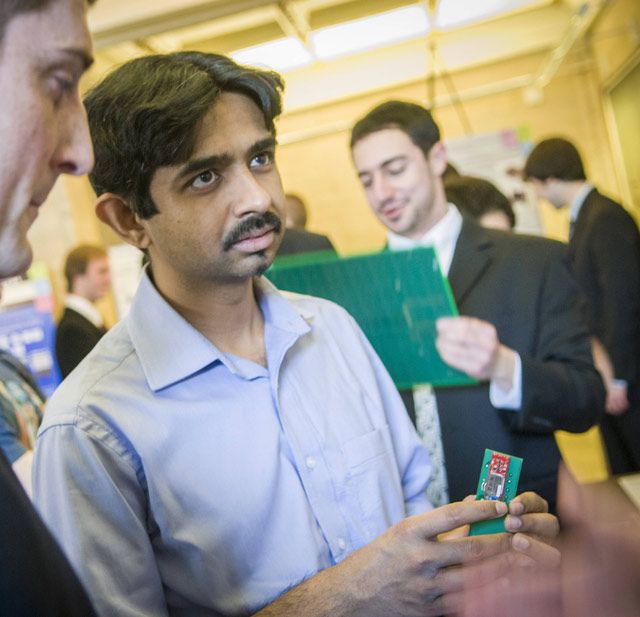Cross-disciplinary Lehigh effort supports DOE efforts in smart grid cybersecurity
The future of energy is about to become safer.
Recently, the U.S. Department of Energy (DOE) has created a new research center that aims to develop new technologies to protect the nation’s power grid from cyberattack. The center, made possible by a $12.2 million grant to Lehigh and four other universities, will develop and test new technologies to help modernize the U.S. electrical power grid. In this effort, Lehigh has teamed up with University of Arkansas, Carnegie Mellon University, and Florida International University, along with industry partner Arkansas Electric Cooperative Corp.
America’s power infrastructure – the “grid” of generating stations and transmission lines that produces and distributes electricity to homes and businesses across the nation -- is aging. Blackouts and recent security breaches have highlighted physical vulnerabilities; less obvious, but equally as important, is a need to update how the grid operates.
Getting smarter about electricity
Recent technological advances have researchers around the world excited about opportunities to develop a better way to deliver power through what is known as a “smart grid.” This term describes an advanced power network that will allow suppliers, distributors, and users of electric energy to control generation, delivery, and consumption of electricity according to real-time information related to supply and demand of electricity at any given moment. Although mass adoption of this technology is years in the future, researchers around the world are working now to bring it to life.
In order to achieve this goal, researchers need to find a way to integrate an information network -- something akin to a cousin of the Internet -- into every nook and cranny of the vast, complex system that connects industrial-sized power turbines to the coffee pot on your counter.
Once this technology is adopted, consumers will be able to determine the most cost-effective usage of electricity through real-time price and availability updates. By avoiding spikes in demand that lead to outages and excessive generation, the smart grid will allow for more efficient and cleaner production and distribution of energy – including the incorporation of alternate power sources, such as wind, waves and solar.
A smart power grid, then, comprises more than just the transfer of electricity – it includes the associated, and instantaneous, transfer of information and money. With all of these intertwined requirements, it’s a goal that involves input from a wide array of scientists, engineers, economists and mathematicians. Collaboration is essential to solving the world’s toughest problems, and the emerging field of research in advanced electrical networks is no different.
And this is precisely where Lehigh’s Integrated Networks for Electricity (INE) cluster enters the picture.
Solving problems through collaboration
Lehigh University is a firm believer in fostering collaboration among researchers in many departments – a notion that sparked the creation of Lehigh’s Cluster Initiative in 2011. The Cluster Initiative includes a broad range of research projects, including Community Health, Integrated Cognitive Neuroscience, Africana Studies, and Digital Storytelling – all of them dynamic examples of interdisciplinary research in action.
According to the INE Web site, this group was one of the first to have emerged from the Cluster Initiative. A multidisciplinary team of faculty and students, INE is committed to research and education on the integrated electrical, information, and financial flows that are the hallmarks of advanced electricity networks.
“It’s an excellent group,” says Rick Blum, the Robert W. Wieseman Research Endowed Professor of Electrical Engineering, faculty lead for the cluster and lead researcher on the Lehigh-DOE project. “It’s mostly young, energetic faculty that I would say are some of the best in the world in the topics they explore.”
The grant in many ways supports the thinking behind the Cluster Initiative, since such a multidisciplinary team is needed to study cybersecurity for energy systems. INE researchers, from a wide array of departments and disciplines, represent the largest team from any of the schools involved in the project. Along with Blum, the group includes Liang Cheng, associate professor of computer science and engineering; Mooi Choo Chuah, professor of computer science and engineering; Boris Defourny, assistant professor of industrial and systems engineering; Shalinee Kishore, associate professor of electrical and computer engineering; Alberto Lamadrid, assistant professor of economics in the College of Business and Economics; Wenxin Liu, assistant professor of electrical and computer engineering; Larry Snyder, associate professor of industrial and systems engineering; and Parv Venkitasubramaniam, assistant professor of electrical and computer engineering.
“Relative to its competition on this project, Lehigh is not a very big school. So to have 9 faculty members on a grant is quite significant and speaks volumes about our growing reputation in this area,” says Rick. “It’s also a really nice validation of the Clustering Initiative itself and the efforts of the INE team.”
-Sarah Plombon '16 is a journalism student interning with the P.C. Rossin College of Engineering and Applied Science.


